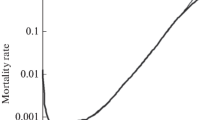Abstract
Age affects mortality from diseases differently than it affects mortality from external causes, such as accidents. Exclusion of the latter leads to the “all-diseases” category. The age trajectories of mortality from all diseases are studied in the five most populated countries of the EU, and the shape of these 156 age trajectories is investigated in detail. The arithmetic mean of ages where mortality reaches a minimal value is 8.47 years with a 95% confidence interval of [8.08, 8.85] years. Two simple deterministic models fit the age trajectories on the two sides of the mortality minimum. The inverse relationship is valid in all cases prior to this mortality minimum and death rates exactly decreased to three thousandths of its original size during the first 3000 days. After the mortality minimum, the standard Gompertz model fits the data in 63 cases, and the Gompertz model extended by a small quadratic element fits the remaining 93 cases. This analysis indicates that the exponential increase begins before the age of 15 years and that it is overshadowed by non-biological causes. Therefore, the existence of a mechanism switching that would explain the exponential increase in mortality after the age of 35 years is unlikely.





Similar content being viewed by others
References
Arbeev KG, Ukraintseva SV, Akushevich I, Kulminski AM, Arbeeva LS, Akushevich L, Culminskaya IV, Yashin AI (2011) Age trajectories of physiological indices in relation to healthy life course. Mech Ageing Dev 132:93–102
Bebbington M, Lai CD, Zitikis R (2007) Modeling human mortality using mixtures of bathtub shaped failure distributions. J Theor Biol 245(3):528–538
Bebbington M, Lai CD, Zitikis R (2011) Modelling deceleration in senescent mortality. Math Popul Stud 18:18–37
Dolejs J (1997) The extension of Gompertz law’s validity. Mech Ageing Dev 99:233–244
Dolejs J (2014) Age trajectories of mortality from all diseases in the six most populated countries of the South America during the last decades. Bull Math Biol 76(9):2144–2174
Dolejs J (2016) Single parameter of inverse proportion between mortality and age could determine all mortality indicators in the first year of life. J Theor Biol 397:193–198
Eurostat (2015) File: demo_pjan. Accessed 22 Jan 2016. http://appsso.eurostat.ec.europa.eu/nui/show.do?dataset=demo_pjan&lang=en
Gavrilov LA, Gavrilova NS (2001) The reliability theory of aging and longevity. J Theor Biol 213(4):527–545
Gavrilov LA, Gavrilova NS (2011) Mortality measurement at advanced ages: a study of the social security administration death master file. N Am Actuar J 15(3):432–447
Gompertz B (1825) On the nature of the function expressive of the law of human mortality. Philos Trans R Soc Lond 115:513–585
Heligman L, Pollard JH (1980) The age pattern of mortality. J Inst Actuar 107(1):49–75
Human Mortality Database (2015) Accessed 23 Jan 2016. http://www.mortality.org
Lin XS, Liu X (2007) Markov aging process and phase-type law of mortality. North Am Actuar J 11(4):92–109
Luder HU (1993) Onset of human aging estimated from hazard functions associated with various causes of death. Mech Ageing Dev 67:247–259
Makeham W (1860) On the law of mortality and the construction of annuity tables. J Inst Actuar 8:301–310
Preston SH, Heuveline P, Guillot M (2001) Demography: measuring and modeling population processes. Blackwell, Oxford
Riggs JE (1992) Longitudinal Gompertzian analysis of adult mortality in the US, 1900–1986. Mech Ageing Dev 54:235–247
Robine JM, Michel JP, Herrmann FR (2012) Excess male mortality and age-specific mortality trajectories under different mortality conditions: a lesson from the heat wave of summer 2003. Mech Ageing Dev 133:378–386
Salinari G, De Santis G (2015) On the beginning of mortality acceleration. Demography 52:39–60
Siler W (1979) A competing risk model for animal mortality. Ecology 60(4):750–757
Strehler BL, Mildvan AS (1960) General theory of mortality and aging. Science 132:14–21
Ukraintseva S, Yashin A, Arbeev K, Kulminski A, Akushevich I, Wu D, Joshi G, Land KC, Stallard E (2016) Puzzling role of genetic risk factors in human longevity: “risk alleles” as pro-longevity variants. Biogerontology 17(1):109–127
Vaupel JW, Carey JR, Christensen K, Johnson TE, Yashin AI, Holm NV, Iachine IA, Kannisto V, Khazaeli A, Liedo P, Long VD, Zeng Y, Manton KG, Curtsinger JW (1998) Biodemographic trajectories of longevity. Science 280:855–860
Willemse WJ, Koppelaar H (2000) Knowledge elicitation of Gompertz’ law of mortality. Scand Actuar J 2:168–179
Witten MT (1988) A return to time, cells, systems, and aging: V. Further thoughts on Gompertzian survival dynamics the geriatric years. Mech Ageing Dev 46:175–200
World Health Organization (1997) The international classification of diseases, 10th Revision, 3-digit codes. Accessed 26 Jan 2015. http://apps.who.int/classifications/apps/icd/icd10online
World Health Organization (2015) Mortality, ICD-10. Accessed 27 Jan 2015. http://www.who.int/healthinfo/statistics/mortality_rawdata/en/index.html
Zheng H, Yang Y, Land KC (2011) Heterogeneity in the Strehler–Mildvan general theory of mortality and aging. Demography 48:267–290
Acknowledgements
This paper was supported by the research project Excellence 2017 and internal research SPEV—Investment in conditions of the concept Industry 4.0, Faculty of Informatics and Management, University of Hradec Kralove, Czech Republic.
Author information
Authors and Affiliations
Corresponding author
Electronic supplementary material
Below is the link to the electronic supplementary material.
Appendix
Appendix
See Tables 3, 4, 5, 6 and Figs. 6, 7, 8, 9, 10, 11, 12, 13, 14, 15, 16, 17, 18, 19, 20, 21, 22 and 23.
Rights and permissions
About this article
Cite this article
Dolejs, J. Modeling Human Mortality from All Diseases in the Five Most Populated Countries of the European Union. Bull Math Biol 79, 2558–2598 (2017). https://doi.org/10.1007/s11538-017-0341-y
Received:
Accepted:
Published:
Issue Date:
DOI: https://doi.org/10.1007/s11538-017-0341-y






















